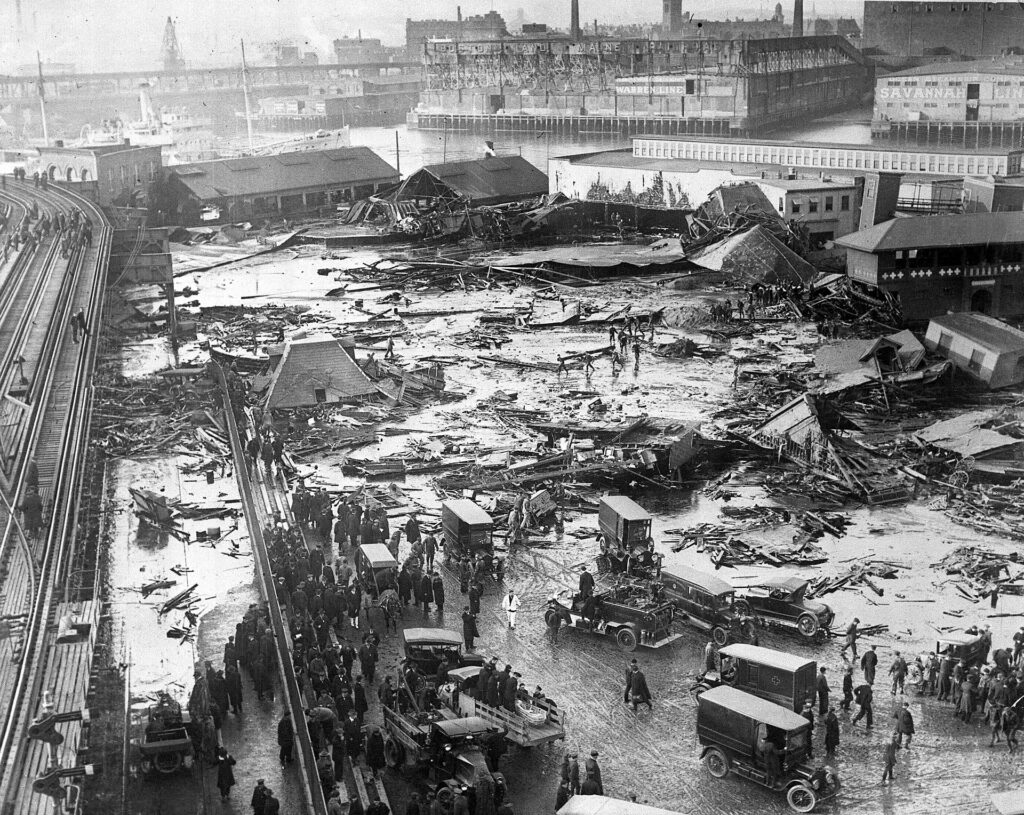Honestly, the only reason we are covering The Great Molasses Flood of 1919 is that someone dubbed it the Boston Molassacre and we think that is the funniest thing we’ve ever seen. The story is rather incredible. On January 15, 1919, a 40-foot tidal wave ripped through Boston. This tidal wave did not come from the sea. No, it was a wave of molasses. This thick, sweet liquid tore through the city streets causing serious damage, injury, and even death. This is the strange and nearly unbelievable tale of the Boston Molassacre (AKA The Great Molasses Flood).
The Great Molasses Flood
At 12:30 pm on January 15, 1919, the main storage tank of the Purity Distilling Company burst. This storage tank stood 50-feet tall and 90-feet wide with a max capacity of 2.5 million gallons. They filled the tank almost to capacity with thick molasses that day. When the tank burst it hurled molasses in all directions. Most notably from the bay in, where it was situated, and directly into downtown Boston. The wave of molasses reached a height of 40-feet and traveled at speeds of 35 mph. Needless to say, the damage was widespread.

Image courtesy of Wikipedia
Aftermath of the Boston Molassacre
The disaster is the single most devastating molasses-related disaster in history. One of the only molasses-related disasters in history, but actually not the only one (see the Honolulu Molasses Spill of 2013). The damage was immense. The wave had pulled entire buildings completely off of their foundation. The blast sent fragments of the tank in all directions damaging property as well. A bystander helped to avoid an even greater disaster. The flood washed away the overhead railroad. This witness ran down the tracks to notify oncoming trains of the danger and urge them to stop.
The Great Molasses Flood damaged more than just property. Officials state that 150 people were injured and 20 others were killed by the disaster. Horses were another casualty of the disaster. One local paper illustrated the horses on the scene as being like, “flies on a fly trap.”
The Rescue Effort
Within minutes a Navy fleet stationed in Boston responded and began wading through knee-deep molasses looking for survivors. The thickness of the fluid made it incredibly difficult to move through the city streets and even more difficult for victims to escape. Many drowned or were suffocated under the molasses.
The Cleanup
It took months to clean up after the disaster. The main method of clean-up was to wash the molasses in the Boston Harbor. After the bulk had been washed out to sea salt and sand were poured across the affected area to soak up the molasses. For years to come, locals described the streets and surfaces as being sticky. Some residents claim that they can smell the molasses on a hot summer’s day even today.
The Legal Fallout of the Great Molasses Flood
Due to the damages, injuries, and loss of life locals assembled the largest class-action lawsuit in Massachusetts history. The case remains the largest in the history of the state to this date and is one of the largest in the nation’s history. Over one hundred residents came forward for the lawsuit. The victims won the case and the company was forced to pay out $628,00.00 in damages (equivalent to $9.3 million today).
What Caused the Boston Molasses Flood?
A combination of corporate greed, negligence, and rapid changes in weather lead to the rupture of the tank. It was an unseasonably warm day for January. The rapid increase in weather altered the viscosity of the molasses in the tank and caused it to exert more pressure on the tank. Since this change in temperature occurred rapidly so did the pressure change and the tank buckled under the pressure.
It was not just the weather that caused the incident. The owners of the tank had hired an inexperienced employee to work as the safety engineer. This individual had little understanding of engineering or safety, so he was unable to spot the warning signs of the impending disaster.
The most noteworthy issue for the tank though was the age-old problem of greed. With the prohibition looming the distilling company was rushing to manufacture and sell as much alcohol as possible while it still could legally. Since they used molasses as a key ingredient in their recipes, they bought it up in massive quantities and stored it in this tank. Even though it had been leaking so much, they just painted it brown to hide the leaks.
Conclusion
The Great Molasses Flood is the single worst molasses-related event in history and also one of the most deadly events in Boston’s history. Contrary to popular belief the tea dumped into the harbor at the Boston Tea Party was actually not the sweetest thing dumped into the harbor in immense quantities. The damages and injuries were many and the Purity Distilling Company paid for their negligence in the largest class-action lawsuit in the state’s history. The Boston Molassacre is another example of corporate greed and negligence leading to catastrophic loss of life and damages. The disaster is, in fact, one of the seminal moments for corporate regulation in America. Find out more about the Great Molasses Flood in this episode of Things I Learned Last Night.
Things I Learned Last Night is an educational comedy podcast where best friends Jaron Myers and Tim Stone talk about random topics and have fun all along the way. If you like learning, and laughing a whole lot while you do, then you’ll love TILLN. Watch or listen to this episode right now!
Sources
The Great Molasses Flood – Wikipedia
Boston Molasses Disaster – HISTORY
Related Episodes
Tell Us What You Think of This Content!
Don’t forget to share with your friends!

